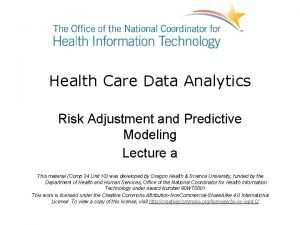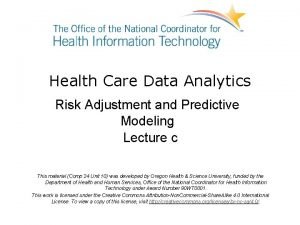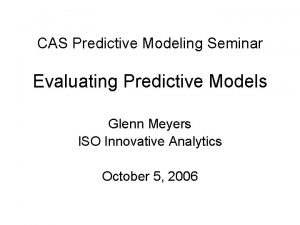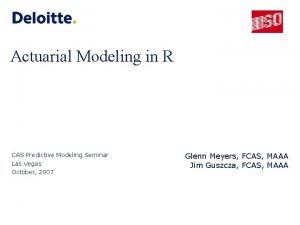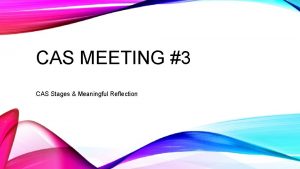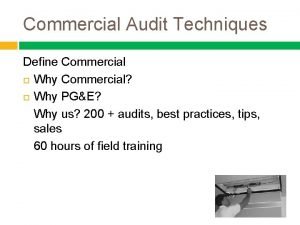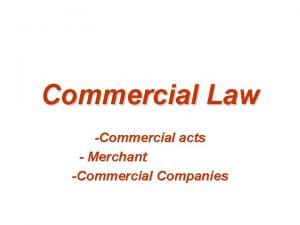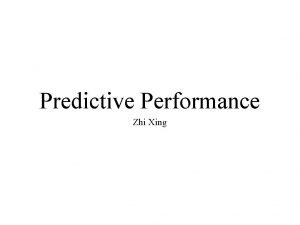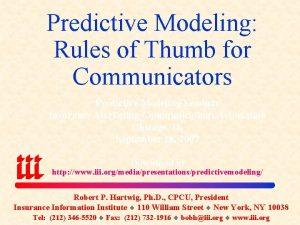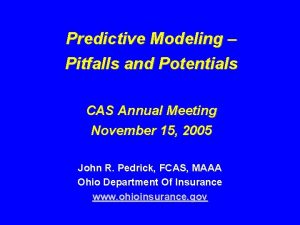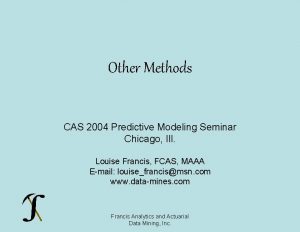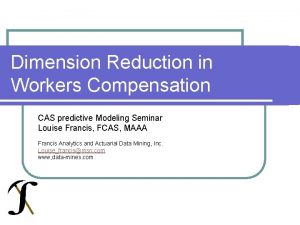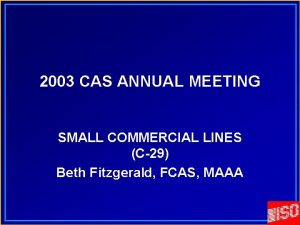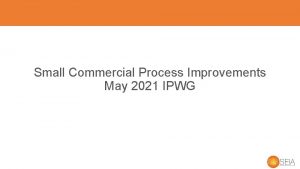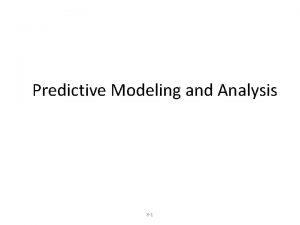Predictive Modeling for Small Commercial Risks CAS PREDICTIVE























- Slides: 23

Predictive Modeling for Small Commercial Risks CAS PREDICTIVE MODELING SEMINAR Beth Fitzgerald ISO October 2006

Agenda • Definition of Risks • Evolution/Challenges of Underwriting • Use of Statistical Modeling • Implementation of Predictive Models • Relativity Analysis

Small Commercial Risks • Size – Area – Gross sales – Low premium • Type of risk – Office, apartments/condominiums, retail, service – Contractors, restaurants, motels, self-storage facilities – Light manufacturing • Rating – CPP vs. BOP

TYPES OF SMALL COMMERICAL RISKS

Growth in Small Businesses Source: Office of Advocacy, U. S. Small Business Administration

Small Business Underwriting Challenges • Low average premium – Doesn’t warrant expensive hands-on underwriting. • Underwritten more as a commodity • Experienced underwriters focused on larger accounts

Underwriting Small Commercial Risks • Establish underwriting guidelines for type and size of risk • Review application information – Numbers of years in business – Financial information – Location information – Building characteristics

Market Research – What the market says it needs • Fast and consistent small business underwriting process • Take advantage of technology • Add intelligence to the policy writing process

What Makes Statistical Modeling Possible? • Advanced computer capabilities – Processing – Data access • Advanced statistical data mining tools

Uses of Statistical Modeling • Scoring of small commercial risks – Improve loss predictability of risks – Increase accuracy of pricing decisions – Cost effective, consistent underwriting • Improve manual rating of risks

Development of Scoring Models • Analyze historical policy and loss data • Link policy and loss data with internal & external data: – Business operational & financial data – Location data – demographic, weather – Other – building, agency • Use statistical data mining software and techniques

Modeling Process Data Linking Data Gathering Data Cleansing Evaluation Analyze Variables Business Knowledge Determine Predictive Variables Modeling

Scoring vs. Rating Manual • Evaluation of scoring variables relative to rating factors • More refined detail than rating manual • Factors not included in rating manual

Modeling Issues with Small Commercial Risks • Less homogeneous risks than with personal lines risks • Variable selection varies by peril and type of risk • Business operational and financial data not always available

Implementation of Model Solution focus/usage: • • • Suitability of risk for underwriting decision Source for additional pricing factors Consistency in underwriting/pricing decisions Compliance with regulations based on implementation decision Consider model alone or model with other information available from application

Implementation of Model Workflows: • Underwriting – – • New Business Renewal business Rating – – Pricing Coverage Adjustment

Business Implementation of Model • Strategic Plan - need management involvement • Prepare Announcement/Training Material for Internal & External Customers • Coordinate Implementation • Monitor Feedback/Adjust Implementation

Benefits of Scoring Model • Reduction of underwriting expense through automated scoring process efficiencies • Fast, cost-effective tool to help you determine which risks to insure • More accurate pricing decisions • Expansion into new markets

Risks of Not Scoring • Lost market share • Greater risk of adverse selection

Use of Statistical Modeling in Manual Rating • Improve rating relativities of current rating factors • Add new rating factor to manual using a multi-variate statistical model

Amount of Insurance Relativities • Amount of Insurance identified as important variable in BOP Scoring analysis • Decision to include as variable in manual and not in scoring model

Multivariate Analysis for Amount of Insurance Relativities • Variables used for Property – Occupancy – Sprinklered–rating identifier – Protection – Construction

Predictive Modeling for Small Commercial Risks • Increased implementation of models in underwriting/pricing of risks • Account view vs. individual line of business view – BOP, CPP, CA, WC • Set of risk component variables in addition to overall score • Additional data sources • Refinement in manual rating
 Predictive risk modeling
Predictive risk modeling Health care risk adjustment and predictive modeling
Health care risk adjustment and predictive modeling Predictive analytics risk adjustment healthcare
Predictive analytics risk adjustment healthcare Aep predictive modeling
Aep predictive modeling Modeling role modeling theory
Modeling role modeling theory Relational vs dimensional data modeling
Relational vs dimensional data modeling Non commercial foodservice
Non commercial foodservice Blomman för dagen drog
Blomman för dagen drog Sura för anatom
Sura för anatom Redogör för vad psykologi är
Redogör för vad psykologi är Mat för unga idrottare
Mat för unga idrottare Geometriska former i förskolan
Geometriska former i förskolan Vilotidsbok
Vilotidsbok Bris för vuxna
Bris för vuxna Presentera för publik crossboss
Presentera för publik crossboss Ledarskapsteorier
Ledarskapsteorier Fspos
Fspos Kvinnlig mantel i antikens rom
Kvinnlig mantel i antikens rom Hur skriver man en tes
Hur skriver man en tes Steg för steg rita
Steg för steg rita Ministerstyre för och nackdelar
Ministerstyre för och nackdelar Tillitsbaserad ledning
Tillitsbaserad ledning Varför kallas perioden 1918-1939 för mellankrigstiden?
Varför kallas perioden 1918-1939 för mellankrigstiden? Bästa kameran för astrofoto
Bästa kameran för astrofoto

